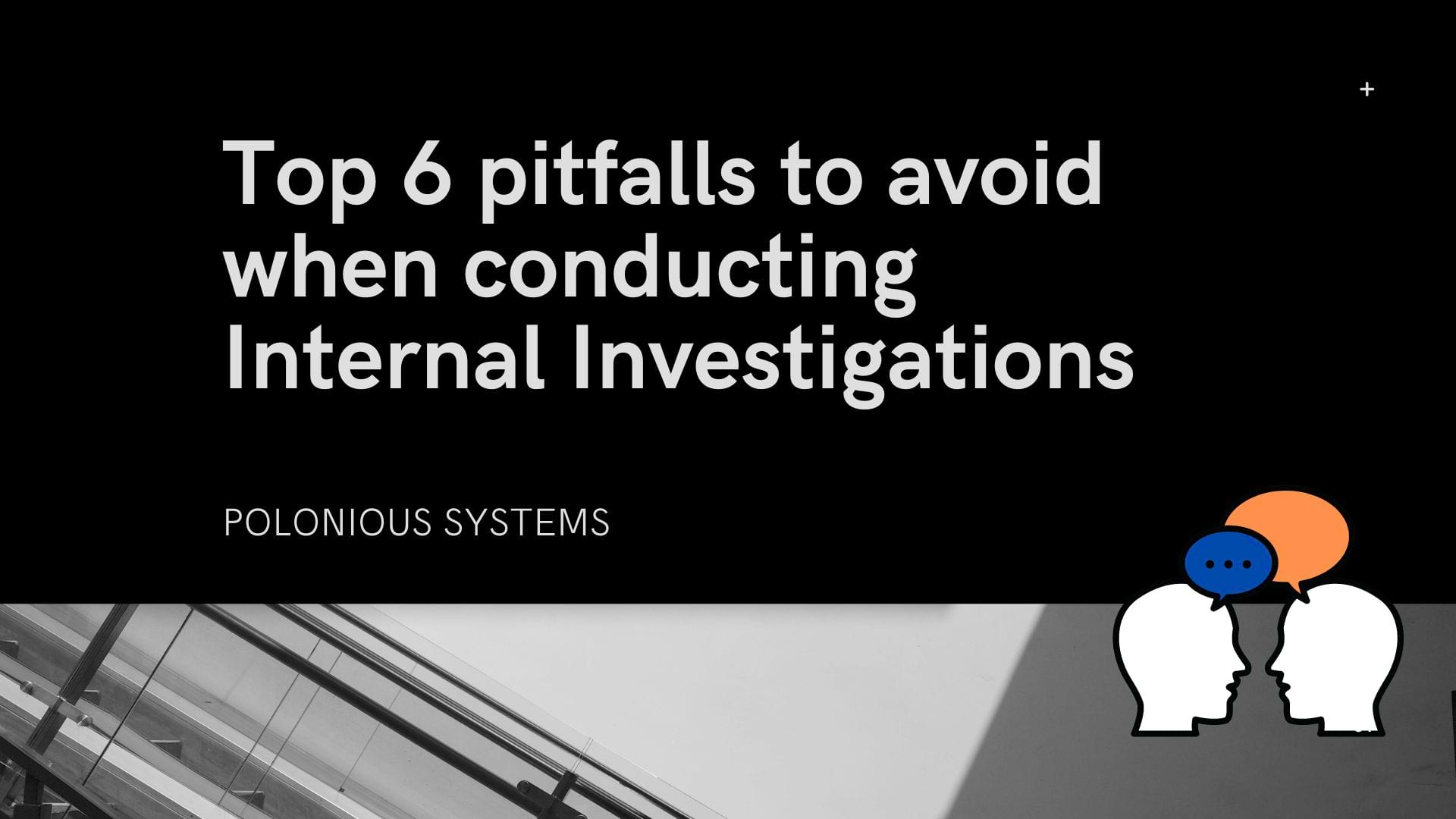Companies will often establish an internal investigation in response to significant events or allegations of wrongdoing. However, minor errors can lead to significant repercussions for employees, employers and companies alike.
Legal requirements have continued to expand in terms of what courts expect employers to do in order to prevent and correct wrongful behavior. It is important to understand the top pitfalls in workplace investigations in order to avoid making the same mistakes and to protect against risk.
In part 1 of our 2 part series in common pitfalls when conducting internal investigations, we will address:
- Determining whether to launch an Internal Investigation
- Top 6 Pitfalls to avoid when conducting Internal Investigations
Determining whether to launch an Internal Investigation
A decision whether to initiate an internal investigation is sometimes extremely difficult to make and may require significant analysis. Although the investigator can decide there are no grounds to proceed, this may create bitter hostility or cause reputational damage to someone who ultimately wasn’t fully investigated. Conversely, great harm can result if a regulator believes that an internal investigation should have been done and the decision was made not to conduct one.
In deciding whether to conduct an internal investigation, a company should take into consideration a number of factors including:
- whether an internal investigation is required by any law, regulation or corporate policy
- the scope and severity of the alleged misconduct and potential violations of law and regulation
- potential or actual interest or litigation by civil regulators, criminal authorities, and third parties
- the benefits and risks to the corporation and/or its officers, directors and employees of such an investigation
Depending on the nature of the misconduct at issue, an internal investigation can consume tremendous resources, at great cost to the company, and potentially expose the company and its officers to greater liability if the internal investigation isn’t conducted properly. In this blog, we discuss things you can do to ensure your investigation is fair and robust. The cost of inaction to a company, however, could swiftly outweigh any expense and litigation risk associated with a properly conducted investigation. Failure to complete the investigation in a credible, timely and thorough manner could also be viewed as an attempt to cover-up wrongdoing.
Top 6 Pitfalls to avoid when conducting Internal Investigations
Mistake 1 – Ignoring Complaints
The first mistake a company can make is to simply ignore a complaint. This can happen despite having established an effective complaint procedure. An employee may suggest they do not want any action, especially if they do not want someone speaking to the respondent due to fear of repercussions. Another common scenario occurs when an employee raises an issue, but wishes to handle the matter on his or her own.
Again, there are certainly circumstances when it is appropriate for matters to be handled by the employee, but you should not fail to look into matters simply because they assume that they are required to honor employees’ requests to either keep issues confidential or resolve issues on their own.
As I’ll discuss below, there is certainly such a thing as overzealousness, but one good rule of thumb might be to consider what your response would be if someone asked (perhaps on the witness stand) six months or one year from now whether you looked into an issue appropriately. If an employee has said he or she feels “harassed,” “retaliated against,” “discriminated against,” or has used some other key phrase, you should carefully analyze a decision to let the employee solve the issue on his or her own.
While most of these decisions (like many decisions related to workplace investigations) will require that you use your common sense and good judgment, be mindful of the strict legal obligations that require prevention and correction of wrongful workplace conduct. Just as importantly, remember that preventing and resolving issues in the workplace is a good business practice.
Mistake 2 – Failure to develop effective complaint mechanisms
Despite companies’ obligation to perform investigations, company representatives still fail to look into issues raised by employees. Sometimes, the failure occurs at the outset, for example when a company fails to provide employees with a reliable complaint mechanism that makes them feel comfortable and safe. Perhaps the company policy does not offer employees an alternative to complaining directly to a supervisor, which may be a problem if the offending party is the supervisor or closely linked to the supervisor. A good complaint mechanism should:
- provide multiple complaint avenues;
- make it clear that once received, complaints of misconduct will be reported to the proper department so that the company can undertake a fair, timely, and thorough investigation;
- indicate that the company will keep information confidential to the extent possible;
- state that if misconduct is found, appropriate remedial steps will be taken; and
- make it clear that employees will not be exposed to retaliation because they lodged a complaint or participated in an investigation about an employee complaint.
The Polonious Case Management System can help you manage complaints including receipt via customer webforms, email ingestion, or manually entered after phone or in-person reports.

Mistake 3 – Failure to plan
Beginning a journey having no idea where you’re headed is dangerous in any situation. In the context of workplace investigations, this happens more often than you would think. Beginning a workplace investigation with an idea of the scope of the investigation—such as which questions to explore and answer—as well as a roadmap for how the investigation will proceed, is critical. The plan may change—you might decide not to interview a witness or you might decide to add a witness to your list, you might realize that you need to review and analyze a document you didn’t know existed, or you might need to add an issue to the scope of your investigation.
Planning requires staying several steps ahead by identifying witnesses and documents; anticipating issues, such as whether you need to make any immediate changes in the workplace (e.g., putting someone on administrative leave, suspending an employee, or changing someone’s shift temporarily); notifying the appropriate departments and managers about the allegations and the investigation; and possibly limiting the parties’ ability to access or, particularly, delete computer records. Keep track of these decisions, making note of the reasons for any change in your planning.
Mistake 4 – Poor Interviews
Internal investigation interviews are crucial to the success of the investigation. The article “Five Common Mistakes in Internal Investigations“, focuses on the importance of interviews during the investigation process:
“Interviews are the greatest source of information for any investigation. Interviewers must be experienced, as inexperienced investigators may act in a combative or unknowledgeable manner that serves no purpose. Investigators should review applicable evidence and interview individuals who may have knowledge related to the allegation prior to interviewing the respondent. This will assist the investigators in asking pertinent questions when they interview the subject and allow them to refer to relevant and potentially incriminating documents during the interview.
It is recommended that two investigators be present during an interview so that one can act as a witness and be responsible for documenting the findings from the interview. The investigative team should also ensure that interview notes are documented in writing, are sufficiently detailed and capture the relevant content of the conversation.”
Mistake 5 – Lack of Objectivity
Investigator objectivity is a principal component of a fair internal investigation. We all may be influenced by our unconscious biases. All investigators should take stock of what those biases might be and make sure that he or she does not allow those biases to influence his or her credibility analysis or influence ultimate conclusions.
In an investigation, there is no such thing as a “bad fact.” All information you collect—whether it supports or contradicts the allegations—will help you to reach a fair and reasonable conclusion. Take a look at Standards of Proof in Workplace Investigations help you obtain relevant evidence and run robust interviews which can help you maintain objectivity.

Mistake 6 – Poor Record Keeping
Proper documentation of workplace incidents and investigations makes a significant difference in preventing risk and liabilities of the organization. Documenting a Workplace Investigation: 3 Things to Know will act as a comprehensive guide for you to understand documentation for internal investigations.
How Polonious can Help
Polonious Case Management Software provides a consistent process that is procedurally fair for all parties, while recording all actions and decisions to ensure all evidence of the process is documented and auditable alongside any evidence gathered regarding the incident or investigation. Everything recorded in Polonious is then available in detailed reporting for identifying trends and problem areas.
Documents of workplace incidents and investigations often contain sensitive materials. Investigators and HR teams have a duty to preserve documents and/or electronically stored information (ESI) while also protecting security and anonymity.
Polonious’ ISO27001 certified security ensures your evidence and case files are stored securely, while our detailed security configuration ensures you can keep employees fully anonymous, or known only to specific individuals, depending on the level of anonymity requested.
Let's Get Started
Interested in learning more about how Polonious can help?
Get a free consultation or demo with one of our experts




